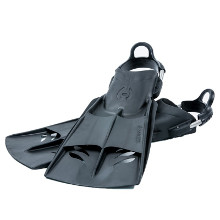After a few decades during which various plastic molds have ruled the market, good old-fashioned rubber fins have made quite a comeback, spurred on by the increasing popularity of technical diving. Short, wide, heavy rubber fins are ideal for technical diving, as they give you a lot of thrust without the fins becoming so long as to be cumbersome in tight spaces, such as inside wrecks or caves. These fins, however, are quite heavy.
The Hollis F1 fin, also known as the ‘bat fin,’ is one of these fins, and a very popular one. With high-quality rubber and a small profile, it moves easily in the water, while simultaneously generating enough thrust to stand a fighting chance against a strong current. But these fins are heavy, weighing in at 7.7 pounds for the pair.
With the follow-up fin, called the F2, Hollis has tried to remedy this by creating a pair of fins that have the same overall performance, but weigh less and are slightly smaller, making them ideal for the traveling tech diver or anyone else who wants a tech-inspired fin without the weight.
The first impression of the F2 depends on your point of reference. If you’re used to plastic fins, you’ll probably find them a bit heavy. If you’re used to tech fins, the fins will seem lightweight. They weigh in just shy of 4 pounds, making them heavier than most plastic fins, but almost half the weight of their full-bodied big brother and comparable fins.
Tech specs
- Material: Monoprene
- Heel: Open
- Straps: Spring straps (adjustable)
- Length: 20”
- Weight: 3.8 pounds
In spite of the reduced weight, they come standard with adjustable spring straps, rather than traditional rubber heel straps, just like the F1. Since most divers who purchase fins like these will likely replace rubber straps with spring straps, this is a definite plus.
They move easily and quickly in the water, requiring a bit less strength to propel them compared to the F1, perhaps due to the extra vents on the blade. This will likely make them more suitable to male divers with smaller frames, as well as female divers. The thrust is still great, though perhaps slightly less powerful than a traditional rubber fin. On one of my test dives I managed to find a good, strong upswell to battle and the fin held up admirably. Maneuverability is totally on par with the F1, except for making a turn while in hover, which seemed to require a bit more finning. Perhaps more practice will make the difference less noticeable.
Wrap-up

Hollis F2 Fin
- Low weight
- Good amount of thrust
- Compact
- Relatively large foot pocket (good for drysuits)
- Quite costly
- Relatively large foot pocket (might be problem with some wetsuit boots)
These fins aren’t cheap, costing almost as much as the F1, but if you’re in the market for a tech fin that isn’t quite as bulky as most, or if you’re looking for a designated travel fin, but want to stick with a rubber fin, this fin is a great choice.
If you are a drysuit diver with “light feet,” who struggles to keep your feet down while in trim, this fin might be a bit on the light side for you. Some divers I’ve spoken to rely on the weight of a rubber fin to help them maintain neutral trim. If this is the case, and you want to make the switch to the F2, you may need a small amount of ankle weight to compensate. Often, however, you can solve light feet-issues by adjusting your overall position of weight and buoyancy. Shift the tank down a bit and move any weights down to ensure that air isn’t getting trapped around the feet and so on.

